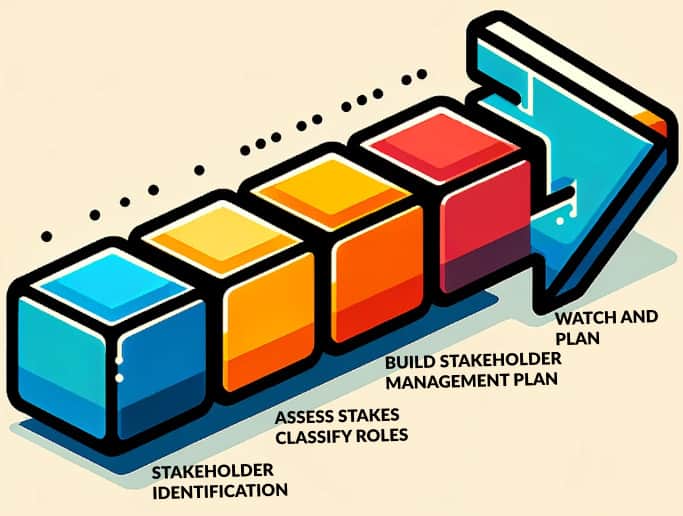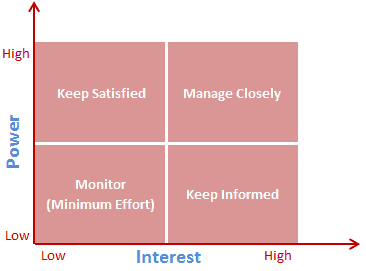Stakeholder Management: A Guide for Project Managers
As a project manager, people management is a key part of your role. No project happens in a vacuum. As the projects you manage get bigger and more complex, you’ll start to notice you’re dealing with more and more people on a daily basis. This is where stakeholder management becomes so important.
At times it can feel like projects (and businesses) naturally position stakeholders and those carrying out the tasks on opposite sides, but this doesn’t have to be the case. We’ll show you how to effectively manage stakeholders so that you can boost efficiency and lead cooperative, successful projects from start to finish.
What are stakeholders?
Before you learn about stakeholder management, you need to know who qualifies as a stakeholder. Although it might seem like everyone you work with is a stakeholder these days, it’s important to clearly define what the term means to avoid confusion.
A stakeholder is anyone who has — you guessed it — a stake in a project. They can be clients, executives, team leads/managers, or even customers, as long they have a vested interest in the project’s outcome.
Key project stakeholders are the people who have initiated the specific project and have the power to make direct decisions that impact the final product. The completion and success of the project will positively impact their team’s KPIs.
For example, say a product management team asks the copywriting team to develop a guide to the company’s newest product. The individual from the product management team who has requested this project is the key stakeholder. They are the person responsible for
- providing a brief outlining the requirements of the project;
- providing feedback and input throughout the process;
- and giving final approval on the deliverables, ensuring that they meet the requirements of the brief.
In relation to stakeholders, the job of the project manager is to manage expectations with thorough communication and collaboration.
Different types of stakeholders
Every project can include different types of stakeholders and that might impact how you interact with them. Here’s what you need to know.
Internal and external stakeholders
Internal stakeholders, also known as primary stakeholders, include anyone who works for your business or organization. They are directly involved in the day-to-day management, processes, and operations of the business. These people include employees, owners, and those on the board of directors.
External stakeholders, or secondary stakeholders, on the other hand, do not have a direct relationship with the company through employment or investment. However, they may still be affected by the actions (or inaction) of the organization. External stakeholders can include customers, individuals in the community, public groups, suppliers, and more.
Stakeholders vs. shareholders
While these terms are often used interchangeably, there are many differences between stakeholders and shareholders.
A shareholder holds units of shares in a company, and therefore has a vested interest in the business’ profitability. This is not necessarily the case with a key stakeholder. All shareholders can be considered high-level stakeholders in key initiatives, but this doesn’t work the other way around.
Another difference? Like external stakeholders, shareholders (other than employees who own shares) typically don’t take part in the day-to-day work of the company. Shareholders are simply interested in the overall ROI of the business, while stakeholders operate more on a project or team level.
What is stakeholder management?
As key stakeholders can either make or break the success of a project, having a strong stakeholder management plan is an essential part of your project management process. Stakeholder management — the process of organizing, monitoring, and nurturing relationships with your stakeholders — has a huge impact on your ability to facilitate projects and keep your stakeholders (and team members) happy.
Proper stakeholder management usually includes identifying your key stakeholders, understanding their needs, expectations, and requirements, and then managing them accordingly through appropriate action and communication.
While many guides to stakeholder management emphasize a need to control your stakeholders and even manipulate them to do what the project manager wants, it’s important to remember that these are professional adults. Instead of a one-way approach, the following stakeholder management processes allow room for nuance and individual interpretation according to your specific context and experience.
Benefits of stakeholder management
Stakeholder management is an involved process, and it adds more work to what is probably already a challenging project. That said, you should consider this an investment in running smoother projects rather than a hassle. When you take time to define and execute on your stakeholder management strategy, you’ll reap several benefits:
- Nipping micromanagement in the bud: Often, micromanagement happens because stakeholders don’t feel like they have enough visibility on important projects. By actively managing your stakeholders’ expectations and seeing to their needs, you’re making sure they have enough visibility on your work.
- Tapping into a breadth of experience: Each stakeholder brings a unique perspective and background. With a stakeholder management strategy in place, you’re giving them a channel for providing feedback and directly affecting the course of your project. This can lead to ideas and solutions you’d have never come across otherwise.
- Achieving better collaboration: Even the best project managers don’t always know what’s happening with other teams. By bringing in a variety of stakeholders and keeping them in the loop, you’ll get access to crucial information that might usually slip through the cracks.
- Keeping projects on time and on budget: This is the kicker. Imagine your project is near its deadline, you’re about to call everything done, and you get a message from an important stakeholder telling you something’s wrong. That can mean suddenly having to push your deadline back — and suffering an awkward call with whoever’s responsible for your budget. With proper stakeholder management, that communication usually comes earlier in the process.
The 4-step stakeholder management process

Now that you know what a stakeholder is and why you need to manage them, let’s walk you through the stakeholder management process.
Step 1: Stakeholder identification
Before you can do anything, you need to find out who your project’s stakeholders are. Some can be identified pretty quickly, whereas for some others you’ll need to ask questions and do a bit more digging. For example, say you’re working on a project to revamp your company’s sales process. The sales lead is an obvious stakeholder, but have you thought about who else might be affected? The customer support team may have to deal with the results of your new process, especially if customers are closed on empty promises. Hence why your CS lead may be a stakeholder in this project.
Step 2: Assess stakes and classify roles
Once you’ve identified your project’s stakeholders, you need to know exactly how they’ll be impacted by it — and how much involvement you can expect from them. You’ll learn the former by examining their role, their daily work, and who they usually collaborate with. For the latter, it’s a combination of knowing how much influence they wield in the departments or teams involved in your project and just how much they care about your project.
Your CEO, for instance, may not be deeply impacted by that sales process project, but they may care deeply about its results and wield their influence accordingly.
Step 3: Develop stakeholder management plan
You know your stakeholders and you know how involved they’ll be in your project. Now you need to figure out exactly how you’ll manage them. That means planning for the following:
- Regular communication: One of the most important things for project managers when building a stakeholder management plan is figuring out their communication strategy. Will you have face-to-face meetings with stakeholders regularly? Reporting on project progress and answering questions asynchronously? Hammering this out before the project begins and communicating it to stakeholders before the project begins is crucial.
- Stakeholder contribution: How much contribution do you expect from stakeholders? Are they meant to provide resources or feedback? Or do you want them to just sit back and let you work? Usually, stakeholders will want to have some influence on your project, especially if it’s closely tied to their own interests. Make sure you identify stakeholder expectations so you can exceed them.
- Escape hatches: What happens when things go wrong? Whether a key team member leaves, a stakeholder moves to a new role, or a conflict potentially derails the project, do you have fail safes in place? Planning these out won’t just allow you to manage situations that come from managing stakeholders, it will also put them at ease.
Step 4: Watch for behavior and plan responses
Much of stakeholder management boils down to regular check-ins with a stakeholder and trying to figure out where their mind is at. You want them to feel at ease, while answering any questions they have and assuring them that things are progressing as intended. This involves some proactivity. For example, if you notice that a specific stakeholder often asks more questions during check-in meetings, you could draft quick, five-minute reports for them before meetings so they’re satisfied that all their questions will be answered.
The role of analysis in your stakeholder management plan
The first step in any stakeholder management plan is to conduct a stakeholder analysis. This process helps you understand your stakeholders, their levels of participation, any potential conflicts, and motivations. A good stakeholder analysis will provide an overview of everyone’s influence and involvement in the project, as well as what is needed for success.
The basic format for a stakeholder analysis consists of the following three core steps.
1. Identify your key stakeholders
While everyone might want a say in the project, your key stakeholders are the people who will have final veto power when it comes to major decisions. To make sure you don’t end up with too many cooks in the kitchen — making stakeholder management a bigger challenge — it’s important to identify them as soon as possible.
Sit down and brainstorm a list of anyone who might be affected by the project. These can be both internal and external stakeholders, and range from the business CEO to clients.
2. Prioritize and organize stakeholders
Now that you have a general understanding of who your stakeholders are, you need to consider what level of power each person or group has when it comes to the actual project. While your customer might be affected by the final product, they may not have the power to block or advance any of the work and tasks involved in its completion.
To determine the impact of each stakeholder, think about how the outcome of the project will influence each listed individual. As the project manager, you should also think about how much support you will need from each stakeholder.
One way to clearly prioritize stakeholders is through stakeholder mapping, otherwise known as a Power/Interest Grid. This is especially helpful if you’re a visual person and enjoy seeing everything laid out in front of you.
A stakeholder map is a standard matrix that outlines the four categories a stakeholder will fall into:
- High power, highly interested (manage closely, must be fully engaged)
- High power, less interested (keep satisfied with strategic communication)
- Low power, highly interested (keep regularly informed to ensure no major issues come up)
- Low power, less interested (monitor but do not require excessive detail or communication)

Once you have your stakeholders plotted on your stakeholder map, you can easily see who has the power to affect your project. From here, you can see which stakeholders will require more communication and management, and let you prioritize your time and energy there.
3. Understand key stakeholders
After you’ve identified the stakeholders who will play the biggest part in the project, you need to take the time to understand their needs, characteristics, and interests. This information will be invaluable once it’s time to work with them directly and manage expectations. At this stage in your stakeholder analysis, you will also clearly define roles and levels of participation amongst stakeholders. If there are any potential conflicts of interest, these will be addressed here too.
Some questions to ask as you work to understand your project’s stakeholders:
- What are their main priorities? And their main KPIs?
- What is the best way to communicate with this stakeholder? (i.e. email, face-to-face, a dedicated project management tool, etc.)
- How much information do they need?
- How do they respond to constructive criticism or conflict?
- What are they responsible for?
- What is their management style?
- Who influences their opinions, and who might be influenced by their opinions?
Setting up short, one-on-one meetings with the key stakeholder to find out the answers to these questions can save you endless time in the long run — plus help build and improve your relationship.
Tips for effective stakeholder management
With your stakeholder analysis complete, the project can finally begin. As you work with stakeholders directly on a daily basis, here are some tips and tricks to ensure the process goes as smoothly as possible.
Define success
To make sure all of your stakeholders and team members are on the same page, it’s important to clearly establish what a successful project looks like to everyone. The project could tick off every box on the stakeholder’s brief, but perhaps the communication was lacking or other elements weren’t up to their standards. To them, this project wasn’t a complete success.
Once everyone recognizes what constitutes a successful outcome, it becomes easier to meet expectations.
Listen closely to stakeholders
Whether it’s a difficult discussion or a stakeholder is simply expressing their needs, it’s important to listen closely to what is being said.
When it comes to conflict management with difficult stakeholders, take a moment to pause and put yourself in their shoes. Think about what they are saying and process it from their point of view.
Outline roles
Nothing causes more confusion during a project than unclear roles. When people don’t know who is doing what, the result is wasted time, frustration, and a delay in task completion. Send a RACI chart to all of those directly involved with the project that clearly outlines everyone’s roles, including those of your project’s stakeholders. Ideally, use a tool like Miro or a PM tool for this.
Keep stakeholders involved
When you have your stakeholder Power/Interest Grid complete, it’s important to actually adhere by the communication levels outlined for each stakeholder. Take an anticipatory approach to communications, relaying key messages or changes to them before they even have to ask. This shows them that you’re aware of their needs and will keep them informed at every stage of the project.
Always answer stakeholder correspondence in a timely manner, and never leave them guessing. When you’re transparent and accessible, you help build stakeholder trust and respect.
Embrace change
It’s important to be flexible when required. We’re not saying you should completely overhaul your stakeholder strategy at the drop of a hat. But stay open to new ideas and changes as required with certain stakeholders. Maybe a stakeholder wants Slack messages to update on progress instead of an email, or maybe they want to be a bit more hands on. Stakeholder management can mean adapting to changing situations and requirements, within reason.
Keep your stakeholder management direct
When it comes to dealing with stakeholders, it pays to be as direct as possible (without being rude, of course). Ask them if they’re happy with the project. Ask them if they require more communication or if the process is working for them. When you avoid passive discussions, you’re able to clearly establish expectations and relationships in the most efficient manner possible.
Better stakeholder management means smoother projects
A key part of running any successful project is to develop and maintain good relationships with those it impacts. With the tips and tools above, you can turn your project stakeholders into effective project partners.
How can you automate stakeholder management?
With a project reporting workflow powered by Unito, you can streamline reporting across tools with less work.
Stakeholder management FAQ
Who is a stakeholder in a project?
A stakeholder is anyone who has an interest in your project’s success. That can be the leaders of the teams involved, individual collaborators affected by your project, and even your c-suite.
What is stakeholder management?
Stakeholder management is a process project managers use to build and maintain positive relationships with stakeholders and keep them engaged throughout a project’s progress. Project managers need to communicate effectively and manage stakeholder expectations throughout their project’s lifecycle.
Why is stakeholder management important?
Keeping stakeholders engaged and informed is crucial to ensuring your project’s success. If they don’t understand the positive impact your project can have on their needs, they may try to shut you down — or show no interest at all. Good stakeholder management can also prevent micromanagement and miscommunications that can sink a project.
What are the 4 steps for managing stakeholders?
The four broad steps of stakeholder management are:
- Identify stakeholders
- Assess stakes and clarify roles
- Develop stakeholder management plan
- Watch for behavior and plan responses


